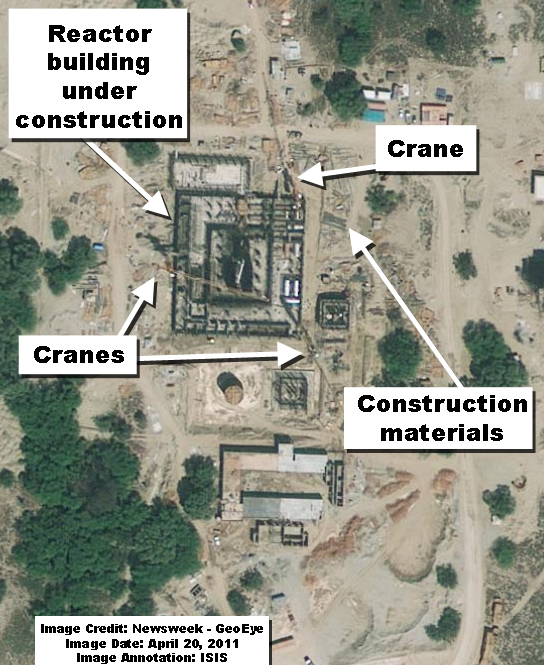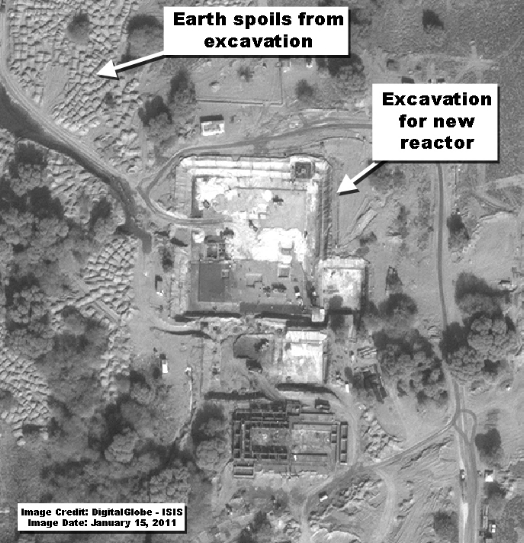Reports
Pakistan Doubling Rate of Making Nuclear Weapons: Time for Pakistan to Reverse Course
by David Albright and Paul Brannan
May 16, 2011
Construction of Pakistan’s fourth plutonium production reactor at Khushab proceeds quickly; when finished, the three new Khushab reactors will allow Pakistan to double its annual output of nuclear weapons. The United States should condition a fraction of its military aid on Pakistan halting production of plutonium and highly enriched uranium for nuclear weapons.
New Satellite Image of Fourth Khushab Reactor
Newsweek has published an article examining Pakistan’s nuclear weapons program that includes new GeoEye commercial satellite imagery from April 20, 2011 of the Khushab military nuclear site (see figure 1). Newsweek shared this imagery with ISIS, and we provided our assessment.
The April 20, 2011 image shows significant progress in the construction of a fourth plutonium production reactor at the Khushab site (see figure 2). On February 9, 2011, ISIS released a report featuring satellite imagery from January 15, 2011 showing what ISIS assessed was excavation for a new reactor (see figure 3). In the April 20, 2011 image, the frame of the reactor building and the main reactor hall are visible. At least three cranes and construction material surround the new building construction. It is not clear from the image if there are any reactor vessel components in the center of the main reactor hall.
The precise pace of construction of the fourth reactor relative to the other Khushab reactors cannot yet be determined from the images—though construction has progressed significantly since January 15, 2011. ISIS noted in a June 21, 2007 report that Pakistan was constructing the third reactor much more quickly than the second. It may be building the fourth reactor quicker than the third one. Nonetheless, the fourth reactor will likely take a few years to complete.
The pace may also depend on Pakistan’s overseas illicit procurement of goods for this reactor. Pakistan was recently implicated allegedly operating an illegal network in the United States to procure goods for its Chashma nuclear power reactor project and perhaps other reactors and plutonium separation plants. The equipment included calibration and switching equipment, radiation detection equipment, and nuclear grade resin used to further purify coolant water.
By comparing satellite images, the fourth reactor under construction appears to be a duplicate of the second and third reactors at Khushab. Figure 4 shows the second, third and fourth reactors at different stages of construction. The dimensions of the main reactor halls are the same, as are the dimensions of the entire reactor buildings. The location of structures adjacent to the fourth reactor building is also the same as the ones near the third and fourth reactors.
The Khushab nuclear site originally contained one heavy water reactor, which Pakistan stated was operational in 1998. Sometime between 2000 and 2002, Pakistan began building a second heavy water reactor at the site. In 2006, Pakistan began construction on a third reactor. In early 2010, ISIS reported that commercial satellite imagery from December 2009 showed vapor rising from the cooling towers of the second reactor, indicating that it was starting operation.
Excessive Stocks of Plutonium
Pakistan’s construction of these new reactors at the Khushab site will result in a dramatic increase in its plutonium production capability. Combined, the three new reactors will be able to produce enough plutonium for over 12 nuclear weapons per year, depending on the reactors’ size and operating efficiencies. 1 This compares with Pakistan’s current estimated production of enough weapon-grade uranium and plutonium for about 7-14 weapons per year. 2 These three new reactors will roughly double Pakistan’s annual ability to build nuclear weapons to about 19-26 nuclear weapons per year.
Pakistan appears to want the plutonium to improve the quality of its nuclear arsenal and build a new generation of lighter, more powerful weapons. Plutonium-based weapons can have more explosive yield in smaller, lighter packages than weapons based on weapon-grade uranium. Pakistan appears to want warheads small enough to fit on cruise missiles it is currently developing. It also may want larger yield (50-100 kiloton) fission weapons that can cause far more damage to Indian cities than its current relatively low-yield weapons. In addition, plutonium-based fission weapons could enable Pakistan to build deliverable thermonuclear weapons (i.e., hydrogen bombs). Thus, the recent activity at Khushab should be viewed as further evidence of an accelerated nuclear arms race between India and Pakistan.
In total, through 2010, Pakistan has produced enough weapon-grade uranium and plutonium for roughly 100-170 nuclear weapons. Based on available information, the number of deployed weapons is probably less. Assuming that about 30 percent of its stock of weapon-grade uranium and plutonium is located in its weapons production pipeline, stored, or otherwise unused in weapons, Pakistan has an estimated total of 70-120 nuclear weapons. It can currently add to that stock at the rate of about 7-14 warheads per year and that value will go up to 19-26 warheads per year when all four Khushab reactors are operational.
Risks of Nuclear Explosive Stock
Pakistan’s great increase in production of plutonium is by itself an inherent nuclear material security risk. The construction of these new Khushab reactors also further complicates attaining a Fissile Material Cutoff Treaty (FMCT). Already, Pakistan is the sole nation blocking the negotiations of this important treaty at the Conference on Disarmament in Geneva.
Recommendation
The Obama administration should publicly insist that Pakistan halt construction of these new reactors at Khushab. Congress should condition a fraction of U.S. aid on Pakistan announcing a moratorium on further construction and agreeing to a FMCT.




1 Albright, Fissile Material Stocks of Israel, India, Pakistan, and North Korea, ISIS, forthcoming. 2 Ibid. The wide range reflects uncertainties in estimates of Pakistan’s production of weapon-grade uranium.

 twitter
twitter